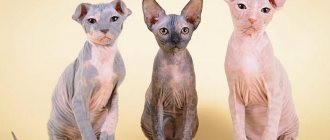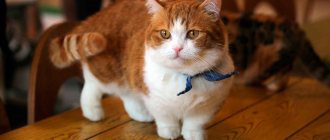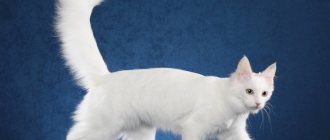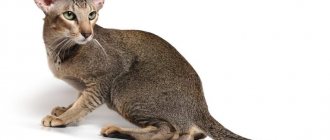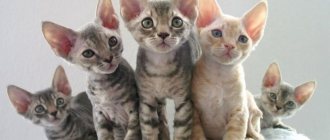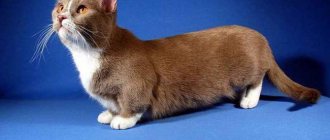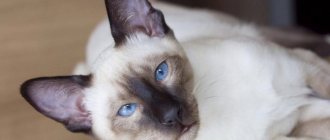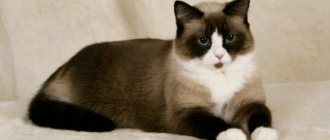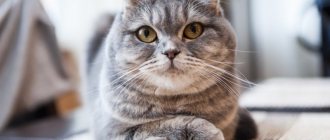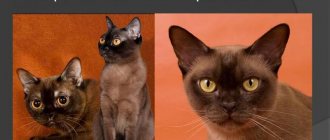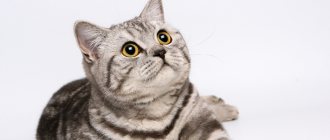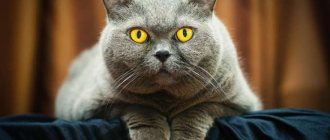Origin story
Anatolian cats (Anatoli or Turkish Shorthaired cat) are an aboriginal breed, formed without human intervention in natural conditions. The homeland of the Anatolians is Eastern Anatolia, namely the Armenian Highlands near Lake Van. Angora and Turkish Van cats, domesticated in ancient times and then re-feralized, took part in the formation of the gene pool of the aboriginal group of Mediterranean cats, which includes the Anatolian breed.
But, despite their long history, Anatolian cats were officially recognized not so long ago. In 1995, an exhibition was organized in the small German town of Castrop-Rauxel. The Turkish breed was represented by 3 cats with eyes of different colors.
European and American breeders highly appreciated the hitherto little-known variety and began breeding the breed and strengthening the characteristic features of the “Anatolians.” In 2000, the breed was officially recognized, and the World Cat Federation approved the first standard.
If you want to buy a healthy animal with a stable psyche and good character, contact only nurseries with good reviews (unfortunately, there are no nurseries in Russia), or contact trusted breeders. The cost of one kitten varies between 20-25 thousand rubles.
Choosing a kitten
Anatolian cats, especially those without heterochromia, do not have a clearly defined characteristic appearance, so it is especially important to buy such a pet only from a reliable cattery or order it at an exhibition: the risk of deception is very high.
Before purchasing, you should carefully check the kitten's pedigree and medical record, as well as the documents of its parents.
You can distinguish an Anatolian kitten from a Van or Angora by its short and coarser coat and the absence of the characteristic “collar” and “pants.”
When you meet the breeder, examine the baby. He should be playful, agile, with clean, smooth fur. Discharge from the eyes, ears or nose, inflammation, dull, tousled fur indicate illness. The mother of the kittens should also look good. All animals should be calm and friendly. Aggression or cowardice are signs of an unstable psyche.
Even adult animals remain active and playful
The price of kittens, depending on the name of the parents and the class of the animal, is 10–30 thousand rubles. White specimens are usually more expensive.
Standards
The Anatolian breed has pronounced sexual dimorphism, that is, cats are noticeably larger, stronger and more resilient than cats. Females rarely reach 5 kg, while the usual weight of males is 6-7 kg.
| Standard | Description |
| Torso | Strong, muscular, with well-developed bones and powerful limbs. Squat, “strongly built” in appearance. The back is flat, the chest is wide (wider than the pelvis). The neck is long and muscular. Limbs of medium length, strong. The paws are round, slightly flattened. |
| Head | Triangular shape, medium size. The cheekbones are high, the profile is straight, the chin is strong. The ears are large, wide at the base and rounded at the ends. Placed very wide, without tilting. Pubescent from the inside. |
| Eyes | Almond-shaped, large, slightly squinting. The iris can be colored blue, green, or yellow, but, according to the rules, it must look harmonious with the color of the coat. Heterochromia - different eye colors - is not considered a defect. |
| Tail | It can't be called long, but you can't deny its mobility. It is well furred, and its tip is a darker color than the rest of the hair on the body. |
| Wool | Thin, with a thin and sparse undercoat (kittens have no undercoat at all). It crunches slightly when touched. The hair on the body is longer than on the legs. Repels moisture and dries quickly after swimming. |
How to choose an Anatolian kitten
The first nurseries of the Anatolian breed have recently appeared in Russia, which, of course, will simplify and reduce the cost of purchasing a kitten. Previously, purebred Turkish Shorthairs could only be bought in Europe or Turkey. The cost of a “pet” class baby starts from five hundred dollars. Buying a breeding or exhibition specimen will cost you three to four times more. Such a high price is due to the fact that the breed still remains quite rare - and, as we know, you have to pay for exclusivity.
Promising show class kittens are very expensive
The aboriginal origin of the Anatolian makes this expensive and rare animal look like an ordinary yard pussy. Often, only an experienced specialist will be able to discern breed characteristics in a small kitten. This circumstance is readily taken advantage of by scammers who offer completely outbred, albeit very cute, babies under the guise of an Anatolian cat.
This cute outbred baby was offered for sale as an Anatolian kitten
To avoid becoming another victim of deceivers, you need to buy a kitten not from random dubious dealers, but only from professional nurseries. Of course, even with such a correct approach, you can stumble upon unexpected pitfalls.
There are known cases when some unscrupulous breeders passed off culling of other breeds as Anatolians: the same Vans or Angora cats (sometimes short-haired babies are born in their litters). And the temptation to sell a breed marriage for substantial money, presenting it as an “Anatolian breed,” sometimes outweighs basic decency.
The magic word “kennel” should not become decisive and final in your choice - make inquiries about breeders, read reviews about their work. If you have the Internet, it is not a big problem to find out at least what breeds a given nursery specializes in.
Ask the breeder to show your kitten's littermates
Carefully read the standards of breeds similar to the Anatolian - their main differences have already been described in this article. Ask the breeder for as many photos and videos as possible of both the proposed baby and his parents, and study their documents together with the specialists. And if personal contact is possible, just stroke the kitten: even the Anatolian baby’s fur is so specific that it is impossible to confuse it. The short fur is both stiff and silky; it creaks slightly under your hand.
When purchasing a kitten, enter into an agreement with the breeder
And most importantly, buy an Anatolian kitten only under an officially certified contract with the breeder. This, of course, is also not one hundred percent, but still a guarantee that you will not be deceived for your own money.
Video: Anatolian kittens playing
Character and behavior
Anatolian cats are playful and cheerful creatures. These “livelings” have a very easy-going character: they treat both family members and guests with equal warmth. But they choose only one “leader”, adopt some of his habits and try to be closer to him.
Representatives of this breed have a much above average intelligence: they quickly get used to their main obligations (going to the toilet in a litter tray, eating only in a specially designated place, sleeping in a separate corner).
They can even do tricks: they easily learn commands such as “voice”, “come to me”, “swim” and willingly perform them. They can warn you if something out of the ordinary happens at home, for example, someone forgot to turn off the tap or the refrigerator.
Anatolian cats love the outdoors. They are not afraid of strangers and other animals, at the same time they are obedient and easily learn to use a leash. If you have a private house, there are no problems with walking, but in the city choose cleaner places: alleys, parks, forest parks.
Does your pet like to go for walks?
HomebodyWalking on the street
Kittens love to play pranks and run around, they are tireless and fearless. As they get older they become much calmer. They are very jumpy: climbing a cabinet one and a half, or even two meters high is not a problem for them. They don’t mind company, but they don’t demand to entertain themselves either. Do not spare money on toys for your pet: Anatolians are very fond of cat play complexes with many ladders, tunnels, hammocks and beds.
A distinctive feature of the Anatolians is their emotionality and musicality. Many cats, upon hearing melodic music, begin to wag their tail and meow, as if singing along. And they meow very subtly and gently, like birds chirping.
What to feed
The Anatolian cat is a child of nature, so it is better to feed it with high quality natural products. The diet should include beef and fish, chicken and offal. Cottage cheese and cheese, boiled eggs can be added in small quantities.
Turkish cats love to feast on food: they will eat as much as is put in their bowl with great appetite.
Interestingly, this beauty is not threatened by large volumes: thanks to its excellent metabolism and activity, representatives of the breed are not prone to gaining excess weight.
Care instructions
This is one of the cleanest breeds, so minimal effort is required from the owner.
Wool
The coat is brushed weekly using a regular cat brush. During the molting period this is done more often.
Bathing
Anatolian cats love to bathe, but they cannot be washed more than once a month: water washes away the protective layer from the skin and can cause dermatitis and other troubles. Use a special shampoo for animals: “Bars”, “Doctor ZOO”.
In the photo are kittens of the Anatolian breed
Ears and eyes
Ears and eyes are examined weekly and, if necessary, washed with chlorhexidine or a special lotion. Nothing should be poured into your eyes or ears! You just need to moisten a cotton swab and gently wipe away the wax and discharge.
Claws
The claws of this breed grow quickly, so, firstly, buy a scratching post, and secondly, trim the claws at least once a month with nail clippers.
Teeth
Teeth are brushed every week using a silicone brush (on your finger) and special toothpaste.
It may also be that this procedure will frighten your pet. In this case, drip gel into the water to strengthen teeth and remove plaque, and have your veterinarian remove tartar from your teeth once a year.
Coat color
The Anatolian cat comes in a variety of colors. Almost all of the existing colors are found in the breed. Siamese, chocolate, and lilac colors are not recognized.
White
Most often, the Anatolian cat has a basic white coat color, on which various tricolor spots, stains, and stripes appear. Pure white color is rare and therefore highly prized.
The most common Anatolian cat is black and white. It is shown in the photo below.
Black
Pure black is rare, but does appear in litters. Black shorthair cats look very graceful. Black fur is shown in the photo.
Grey
Gray Anatolians are rarely born. However, they look quite noble and vaguely resemble the British. If the owners give birth to a gray cat, they can be considered lucky.
Ginger
The red Anatolian cat appears quite often in the litter. There are also white and red or even copper kittens. Their fur may have spots, stripes on the body; pure red color is almost never found. The Anatolian cat in the photo is presented in 3 colors - red, white-red and tri-colored tortoiseshell.
Tabby
The tabby color is a standard striped color, like the cat Matroskin. The shade of the stripes may vary. The most common colors are red, gray and brown.
Bicolor
Two- and three-color colors are the most common among representatives of the Anatolian cat breed. The base always remains white with black, red, and cream spots visible on it. A beautiful specimen is shown in the photo.
Catering
The Anatolian cat is not picky when it comes to food, and willingly eats everything its owner gives it. Therefore, choose what is more convenient for you personally: cook it yourself or buy ready-made industrial feed.
Natural products
Anatolian cats (provided they are healthy) have an excellent appetite, but due to their activity, they are practically never overweight. Calculate the amount of food as follows: 30 grams per 1 kilogram of animal weight. At least 4/5 of the diet is proteins, the rest is fats, carbohydrates, vitamins and minerals. Adults (over six months old) eat in the morning and evening, kittens - 4-5 times a day.
It is prohibited to give:
- Fatty meat (pork, goose meat, duck meat), rotten meat, lard, tripe, any (even small) bones;
- River fish (it tends to accumulate toxins);
- Sweets (sugar, marmalade, chocolate, marshmallows, etc.);
- Smoked, fried;
- Baked goods (bread, buns, cakes, cookies, etc.);
- Flour: pasta, etc. (they do not provide any benefit, and it will be difficult for the stomach to process them);
- Spices, seasonings, ketchup, mayonnaise, sauces;
- Pickled vegetables, canned food;
- Sausages, sausage;
- Legumes, potatoes, corn, eggplants, fruits (avocados, grapes, citrus fruits);
- Human drinks (alcohol, juices, carbonated drinks, mineral water, coffee, tea, cocoa);
- Dog food.
Allowed to give:
- Fresh lean meat: veal, beef, chicken, turkey, quail and rabbit meat (do not boil, but defrost and pour over boiling water);
- Sea fish (trout, salmon, hake, flounder), shrimp, squid;
- Dairy products without harmful additives and low-fat (sour cream, yogurt, fermented baked milk, Varenets, cottage cheese, unsalted hard cheese);
- By-products (liver, chicken hearts, stomachs);
- Boiled chicken yolk, quail eggs;
- Stewed or boiled vegetables (white cabbage, green beans, pumpkin, carrots, zucchini);
- Cereal porridge: oatmeal, buckwheat, rice, barley.
The bowl should always be filled with fresh water that is comfortable for drinking. You cannot feed your animal untreated tap water: first pour the liquid into a jar and leave it for a day without a lid in a dark place so that chlorine and other harmful compounds evaporate.
In the photo there is an Anatolian cat on vacation
Recommended food
If you don’t have time to cook, choose ready-made food. The cheapest are economy class: TerraCot, Friskies, Purina One. Unfortunately, this is far from the best option. These feeds are based on meat production waste (and there is practically no pure meat), plant ingredients, and a minimal amount of minerals and vitamins.
Premium food: Ontario, Safari, Mnyams are more expensive, but it cannot be said that their composition is better. The source of protein is most often corn gluten (a fairly strong allergen); the percentage of ingredients is not indicated on the packages, which is also a serious “minus”.
Super-premium and holistic food - optimally suited for Anatolian cats. The ingredients are not satisfactory: dehydrated and fresh meat, fish fillet, natural preservatives, dried berries and fruits, a good vitamin and mineral complex. Holistic: Now Fresh, Orijen, PureLuxe. Super premium food: 1st Choice, Arden Grange, Brit Care.
Below are recommended super-premium foods. Links with the names of the feeds are clickable, on them you can, within our website, read the descriptions of the feeds and read reviews from the owners of the Anatolian breed.
| Holistic | Super premium | Super premium |
| Nutram | Airi | Bozita |
Purchasing a kitten
The Anatolian cat is a rare and not very popular breed, so there are no specialized nurseries in our country yet. But purebred kittens can be found from private breeders and in some nurseries that breed other breeds (Turkish Van). They position such animals as exotic.
Buying a purebred kitten is very difficult
Anatolians are bred in Turkey, Greece, Germany, and the Netherlands. There is an anatoly nursery in Armenia.
Criterias of choice
You should only purchase a kitten from a nursery or from a reliable and honest breeder. Visually, it is difficult for a non-specialist to distinguish Turkish cats from ordinary mongrel cats, so you need to carefully study all the reviews and try to contact the owners directly. Otherwise, for decent money, you can get a pet that does not have unique and characteristic characteristics for this breed (a unique voice, intelligence, etc.).
The baby Anatoli will differ from the Turkish Van and Angora in having shorter fur, as well as in the absence of the characteristic fur collar on the neck and “pants” on the hind legs. The fur on the face and entire body of Anatolian kittens is much less fluffy and slightly stiffer than that of other Mediterranean cats. The hairs on the tail are slightly longer than the main coat. In Angora and Van this difference is more significant.
It is imperative to look at the kitten’s parents; they must have all the breed characteristics of an Anatolian cat.
Thoroughbred Anatolians come to our country from Europe and they always have documents confirming their origin.
The baby should look healthy
When choosing a pet, you need to pay attention to the following factors:
- The baby's ears and eyes are clean and do not have any discharge;
- white teeth, light pink palate;
- the tummy is soft, when you touch it the animal does not experience severe discomfort;
- the fur is soft, without sticky or rolled areas;
- the kitten must be active, not cough, sneeze, etc.;
- The baby should not be too afraid, since this breed is not particularly timid.
Kitten age
Experienced breeders donate babies no earlier than eight weeks, when they are already eating like adults. It is better if all the vaccinations required for this age are completed.
Health
The Anatolian breed boasts excellent immunity and the absence of genetic diseases. And if you follow the vaccination schedule, then your pet will not be afraid of most infectious diseases.
The issue of breeding Anatolian cats is still acute, since this breed is still quite small in number, and crossing them with other breeds is prohibited by the rules. When choosing a “soul mate” for your animal, ask the owner the following questions: does his animal have a pedigree and breeding clearance? What illnesses did the cat's parents have?
“Match” your pet with an active, healthy animal that has received all the necessary vaccinations and has been raised with love and care. The first estrus in females occurs at 7-8 months, males are ready for breeding no earlier than 1.5-2 years.
Early pregnancy leads to the birth of frail offspring, and frequent childbirth leads to physical exhaustion of the cat. 1-2 times a year will not cause damage to health.
If you do not plan to breed, spay (neuter) the animal. Females are operated on for up to two years (optimally - between 8 and 12 months), males - from 10 months to 2 years.
Expert opinion
Dusheba Vera Ivanovna
In 2010, she graduated from the Moscow State Academy of Veterinary Medicine named after K.I. Scriabin with honors, specializing in veterinary medicine. I regularly attend veterinary conferences, congresses, and webinars.
Don't forget to deworm: once a quarter (regardless of whether the cat is outside or not).
Hereditary diseases
The breed is close to its natural wild appearance. An animal formed in the wild does not have genetic abnormalities.
The Anatolian cat loves warmth and comfort. If she often walks outside, or if there is a draft in the house, she may become hypothermic. In case of hypothermia, there is a risk of respiratory diseases. Treatment is carried out according to the standard scheme:
- For fever, antipyretic drugs are prescribed.
- For coughs - expectorants.
- In severe cases, antibiotics are prescribed.
- Additionally, vitamin complexes and immunostimulants are prescribed.
Ask your veterinarian for the exact diagnosis and medications. The characteristics of the disease are also clarified in the clinic.
Additionally, the owner can:
- give the animal a massage;
- apply homemade warming compresses;
- drip eucalyptus oil onto the litter, so the nasal passages will work better so that the cats have access to oxygen;
- wipe your nose with a cotton pad;
- provide access to warm drinks.
Turkish breeds
The ancient state of Anatolia, once located on the territory of modern Turkey, was beautiful and rich.
The ancient Turks called their country Anadul, the Greeks - Anatol, the Slavs, following the Greeks - Natolia, but all this meant one thing - Bridge. And this country truly represented a bridge between the West and the East, even the great rivers Tigris and Euphrates begin their sources in Eastern Anatolia. And, if the ancient Romans said that all roads lead to Rome, then the peoples living in Anatolia were firmly convinced that all roads would sooner and later lead to the sacred Lake Van - one of the oldest and largest salt lakes in the World.
According to these peoples, those who swim at dawn in the waters of this relict lake get rid of diseases and receive the grace of the ancient lake spirits.
These are the cats of the sacred Lake Van, known as the Turkish Van, Angora and, of course, the Anatolian cat. Photo (white with different eyes)
For inexperienced people, the appearance of these “lake nymphs” may indeed seem like a miracle, but not for archaeological scientists! It was on the Anatolian Plateau that the oldest burial of a domestic cat was found - 9,000 years old! While the burial in the south of Egypt (Asyut) dates back to only 6,000 BC, and on this basis the erroneous conclusion is made that domestication (the process of domestication) of cats took place around 2,000 BC.
Anatolian diseases
Nature has endowed Anatoli with healthy genetics and strong immunity. That is why representatives of the Anatolian breed rarely suffer from serious diseases. They only have infectious and parasitic diseases that are common in all cats. Anatolian cats are also at risk of urolithiasis, which is often caused by an incorrectly selected diet.
Thanks to good health, the age of pets can reach 15-20 years.
Despite impeccable genetics and good health, Anatolian cats also require common cat procedures: vaccination and prevention of internal parasites on a schedule, monitoring of physical indicators.
Anatolians enjoy good health
Reviews from Anatoli owners
I don’t know how to describe the admiration that knows no bounds for this cat.
He is like a member of our family; if something suits him, he purrs and calls for him, indicating what is needed. On our farm, we have nutria, quail, and chickens who were worried that he wouldn’t touch them, but he pays zero attention to them, he will carefully climb out onto the box and lie down over them. But it can sit in ambush for a day on a mouse or sparrow, and still chirp, distracting the bird’s attention. It happens that I turn on the microwave and go to the computer, the microwave starts beeping when it’s finished, so the cat, sitting across the room, comes up and calls, touching his shin with his paw, calling me to the kitchen. He specially left sausage on the table, the fish was already dry until the morning, and in the morning he comes to the bed, checks that his wife is breathing, I am breathing, comes up to my feet and starts rubbing his heels with his mustache. What do you think? You need to get up and go to the feeder and show him where and what to eat. Sometimes at night he gets bored and comes up to him, wakes him up and calls him to the computer. ria
https://xn--e1afgbgom0e.xn--p1ai/forum/forum2/topic213/
I have Anatolian.
Very angry. He only loves me, he can’t stand strangers. He doesn’t like my parents, especially my dad. Very clever. I don’t know about everyone else, but mine doesn’t steal from the table. Very faithful. With such a cat, a dog is not needed Kareli908
https://www.zooclub.com.ua/2668?t:354
For a non-specialist, EKSH is no different from domestic cats. Anatoli cats are intelligent, with a gentle melodious voice.
Not only do they love to swim, but they have water-repellent outer hair, so they dry quickly. Each breed has its own characteristics. Soul
https://eursh.ru/forum/viewtopic.php?f=27&t=179&sid=f8f5ae0ef612a687afe1872f09c3a962
A unique breed: at first we thought the kitten was strange - it doesn’t meow, but chirps quietly.
It turned out to be a peculiarity of Anatolian. A very intelligent animal! The coat is without undercoat, very silky to the touch - you want to press it to your cheek... A very sociable animal, it doesn’t stay alone in the room if someone at home is sure to run after us. My child chuckled sarcastically about the “intelligent animal.” What a very curious girl! He wants to stick his nose into all your affairs - from the computer to the broom! And if he sees a small ball or a laser in his hands, he prepares a show for the whole family. Jumping after a target to the ceiling with a flip in the air is a very impressive sight! Anatolievna
https://mauforum.ru/viewtopic.php?f=108&t=19001&sid=df00d2747f5917e39d9126109bc3d662
When the summer season began, high hopes were placed on my home hunter: we believed that she would catch all the rodents.
But it was not there! The cat ran around the house and stomped like a hippopotamus - what a hunt there is! We decided that she didn’t know what a mouse was, and we needed to “introduce” them. They caught the rodent in a box and brought it to Krita - study it, they say. The mouse froze and did not breathe. The cat extends its paw and, touching it lightly, immediately pulls it away with disgust and shakes it, as if it had gotten dirty! She turned away and walked away! Tatyana Stepanova
https://zcats.ru/porody_koshek/stati_o_porode/98-anatoliyskaya-koshka.html
